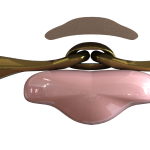When you put a bit in your horse’s mouth, you might look at it and think, ‘Yeah, looks good to me’ but the position you see it in from the ground may not be the position in which it will sit once you’re on-board. When a contact is taken up on the reins, the mouthpiece will usually rotate in the mouth meaning that what you saw when you looked from the ground is no longer the case. We call the angle at which it sits the ‘working angle’ and this is really the position that matters when choosing a bit.
The Dr. Bristol patent describes the way in which Dr. Bristol himself intended the bit to be fitted. The way it was intended would have meant that the central plate would, upon rein contact, sit flat against the tongue, therefore benefiting from a great weight bearing surface. Unfortunately, Dr. Bristol seemingly came before his time, and the way the bit sits before contact makes it look less comfortable and it wasn’t realised that the bit would change position upon contact. Because it looked uncomfortable before contact when placed in the mouth the way it was intended, it is often fitted the wrong way around which means it sits much like a French link would.
You may expect the French Link to sit with the plate flat on the tongue but the truth is, it never sits like that. When placed in the mouth with no contact, it sits with the plate at an upright angle to the tongue and when contact is taken up, it rotates back and sits with the edge of the link digging down even further into the tongue with very little weight-bearing surface making it much harsher than expected.
For the French Link to stay in the position seen before rein contact, the bore axis (the hole in the mouthpiece that the rings pass through) would need to be put through at a different angle, accounting for the degree of rotation seen upon rein contact. Even then, the loops of the cannons, which hold the link would be directed down onto the tongue.


















